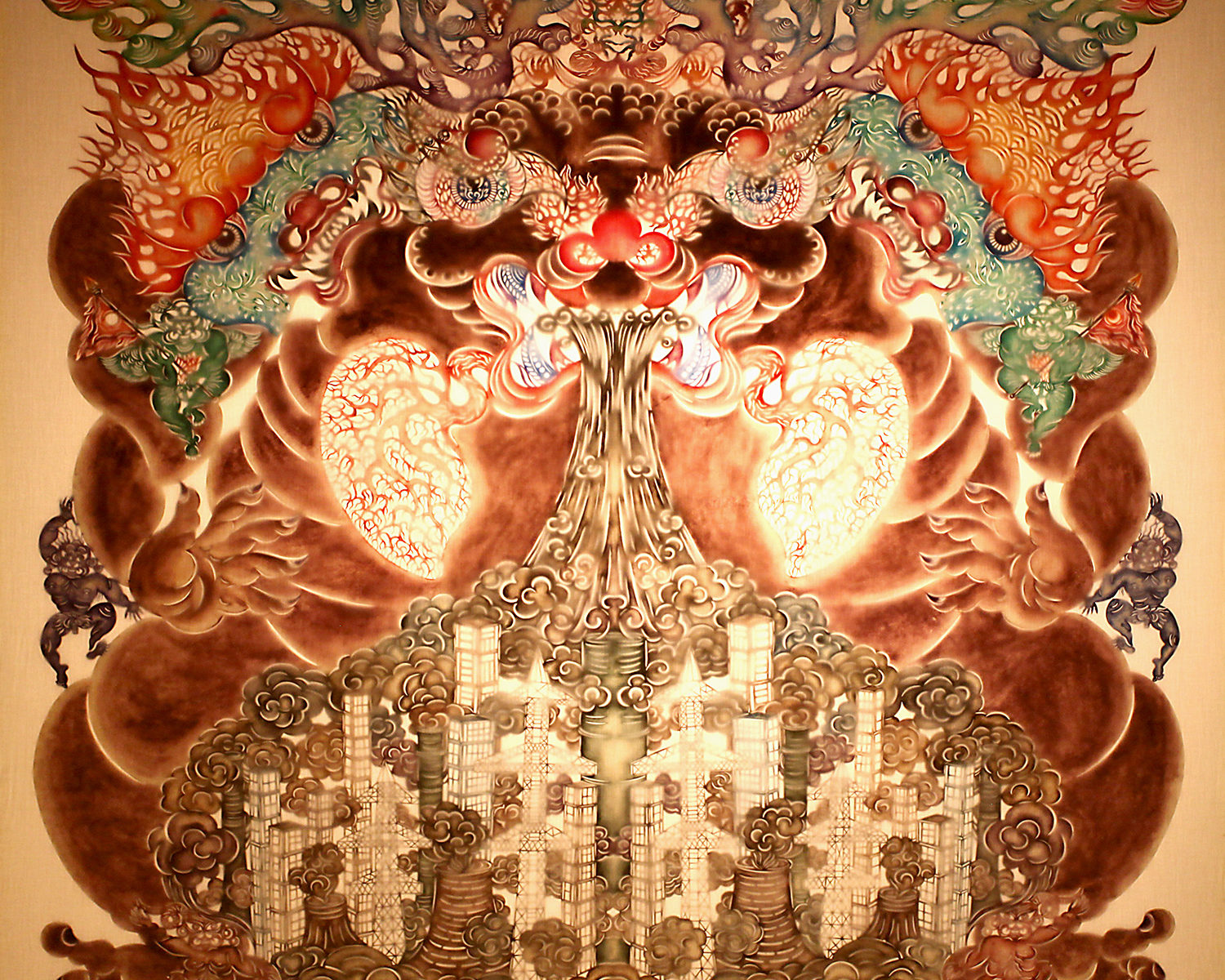Chinese to English interpretation by Fei Zhao
I recently met up with Cui Xiaoqing 崔小清, who is a visiting artist at International School of Beijing. During a gap between classes, we closed the art room doors and sat down at tables designed for humans half our size to discuss his work. Though Cui was rather taciturn and soft-spoken at first, he became more animated the more he explained his work. The artist has been interested in paper cutting since childhood, but he’d always considered it a bygone tradition. Like most young artists, he devoted himself to painting and drawing. Later, as a graduate student at the Central Academy of Fine Arts, he studied under Lü Shengzhong. As China opened up in the 1980s, most of Lü’s contemporaries rushed to embrace international art trends, but Lü reacted against the constraints of social realism in an opposite way—by reviving the folk art of paper cutting. Lü’s inventive use of this medium (intricately textured collage, flowing installations and artist books) made Cui realize that the technique could be used to do much more than create window decorations. When Cui began to experiment with paper cutting himself, something clicked.
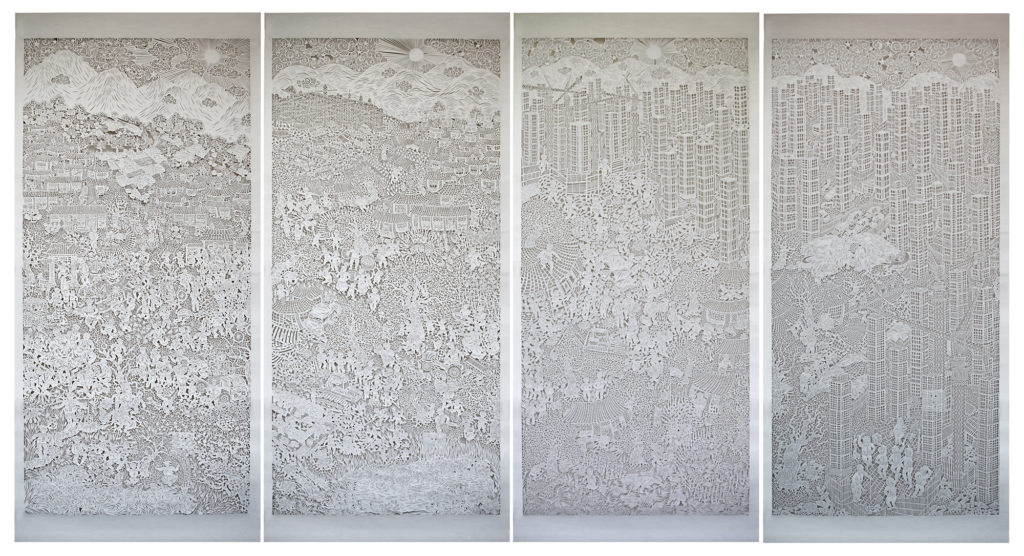
Like his mentor, Cui creates work that is simultaneously delicate and massive. However, his focus is often on a more narrative observation of contemporary Chinese life. “Changes in the Mountain Township: Spring, Summer, Fall, Winter” (山乡巨变之春·夏·秋·冬) depicts the changes wrought by urbanization. He told me that much of the imagery is based on personal memories of his hometown Datong, though the story it tells would be familiar across China. As one moves from left to right across the four panels (that is from spring to winter), the same bucolic landscape is increasingly dominated by the machinery of construction. In the final panel, the trees are mere stumps, a pond teeming with fish has vanished, and a cacophony of identical towers nearly blots out the mountains in the distance. Though it is tempting to read the work as social criticism, Cui insists he is merely documenting modern life. Indeed, his attitude seems to reflect a widespread Chinese ambivalence about the benefits and costs of modernization. Another startling aspect of this piece is the sheer intricacy of the design. Though it measures 190 x 90 cm, the scenes within it are relatively tiny. When I stood close to inspect these details, I was quickly swallowed into a vast field of white forms flowing in and out of each other. Because each panel is meticulously cut from a single sheet of paper, the people, buildings, trees, farms, and cars are all connected. Incredible patience and control is needed to create a paper cutting of this scale. “Changes in the Mountain Township” was created over a period of two years, from 2016–2018 (which, it seems, might be a pace equivalent to the transformation of a stretch of Chinese countryside).
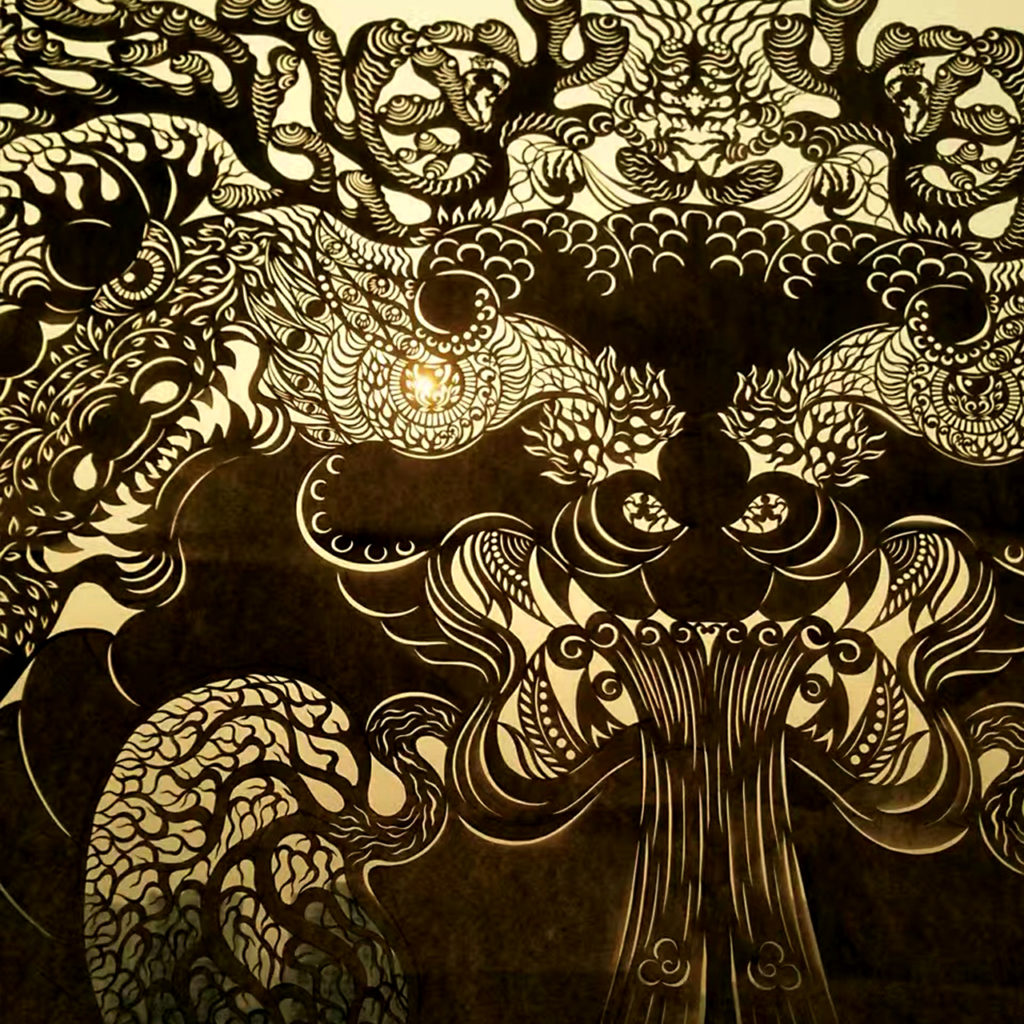
“The Great Immortal who Inhales Pollution” (吸霾大仙) portrays the ubiquitous problem of air pollution. At first glance, the monstrous visage of the spirit towering above the city might seem to mark it as a personification of smog. However, Cui told me that the creature is not spewing out fumes, but sucking them in. This being is actually related to Sao Qingpo, a benign Chinese spirit who sweeps away clouds with her broom. Paper cut images of Sao Qingpo are traditionally quite common in rural China as a means of petitioning the heavens for favorable weather. “The Great Immortal” is actually then an image of hope for a more sustainable future. When the work is backlit, the painted paper emits a hazy sfumato glow befitting this divine being. Cui’s more complex works, such as this one, require him to hand draw a template. An advantage of this method is that multiple cuttings are possible, and some works exist in both color and black and white, each with its own distinct visual qualities.
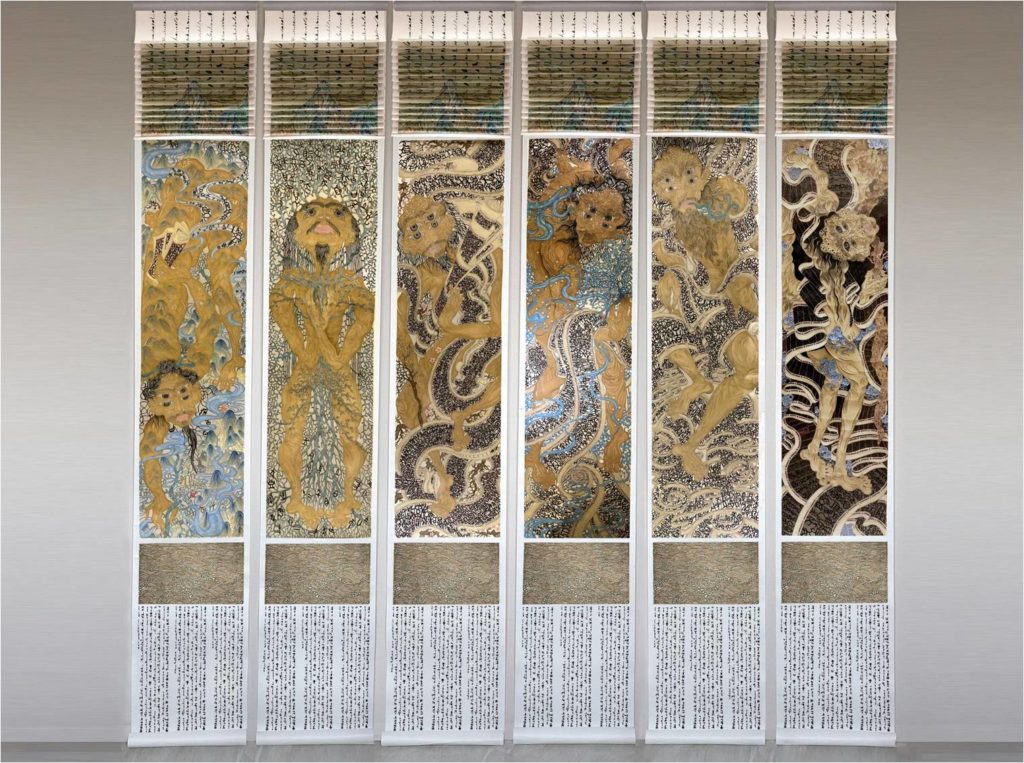
Another piece, “Six Scripts” (六书), is about the evolution of Chinese from a system of loosely interpreted symbols to a complex and precise written language. Cui says that he became intrigued with etymology after teaching written Chinese to children. As the oldest living writing system in the world, Chinese characters contain ideograms, pictographs, pronunciation and semantic information that can be combined in several ways. The first organized attempt to analyze their composition was compiled by the Han dynasty scholar Xu Shen, who recorded six distinct classifications, or 六书. A more colorful interpretation of Chinese word origin revolves around Cangjie, an earlier (possibly mythical) scholar. Fantastic tales characterize this ancient sage as being tasked by the Yellow Emperor with single-handedly inventing writing. According to legend, he sat on the banks of a river interpreting divine omens in order to create a set of characters that reflected the true nature of each thing he observed, and when he succeeded, the gods wept and the sky rained millet.
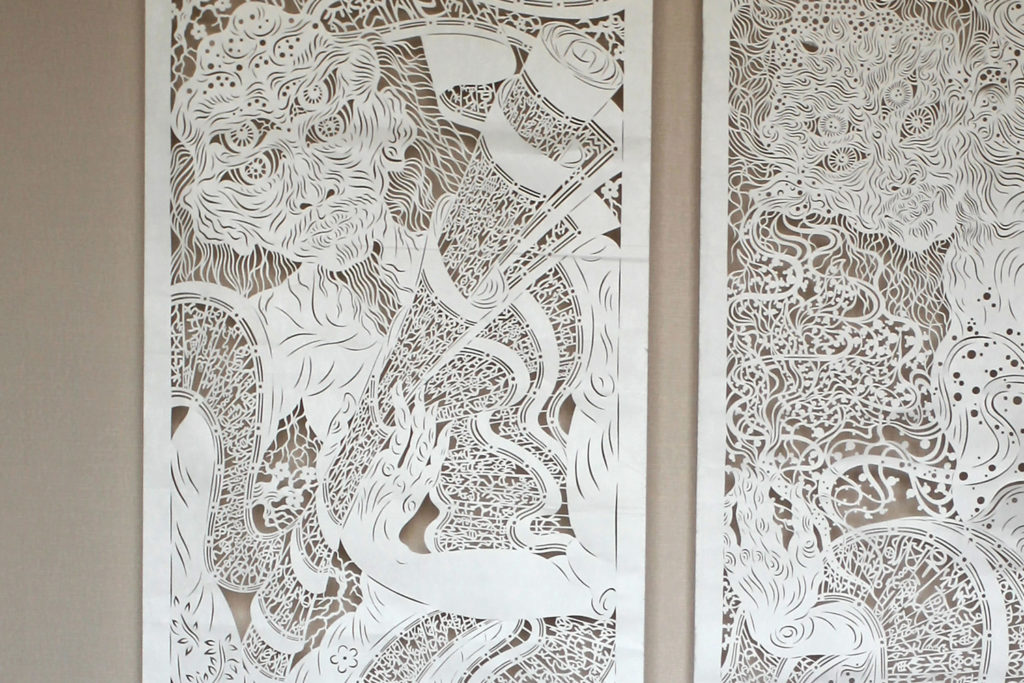
This reverence for the written word is reflected in the four-eyed Cangjie who snakes through the panels of Cui’s artwork. Oracle bone script characters are embedded in mountains, carried in the currents of rivers and intertwined with the patterns of crisscrossing branches. Cangjie himself also merges with this primordial landscape and the oldest known Chinese script which springs from it. The apparent columns of text at the bottom, resembling modern Chinese, are intriguingly not writing at all, but only the scraps from Cui’s cuts, repurposed as a visual pattern. In doing so, he reminds us of the common origin of writing and drawing. While the inspiration for “Six Scripts” is ancient, it points to a central struggle of representation which is just as fresh today as it was in the bronze age: the problem of how to triangulate between our perception, the things we perceive and the abstract code of language. The visual language of art carries with it a similar puzzle. Cui Xiaoqing’s paper cuttings are but one strange and beautiful solution.
~~~

~~~
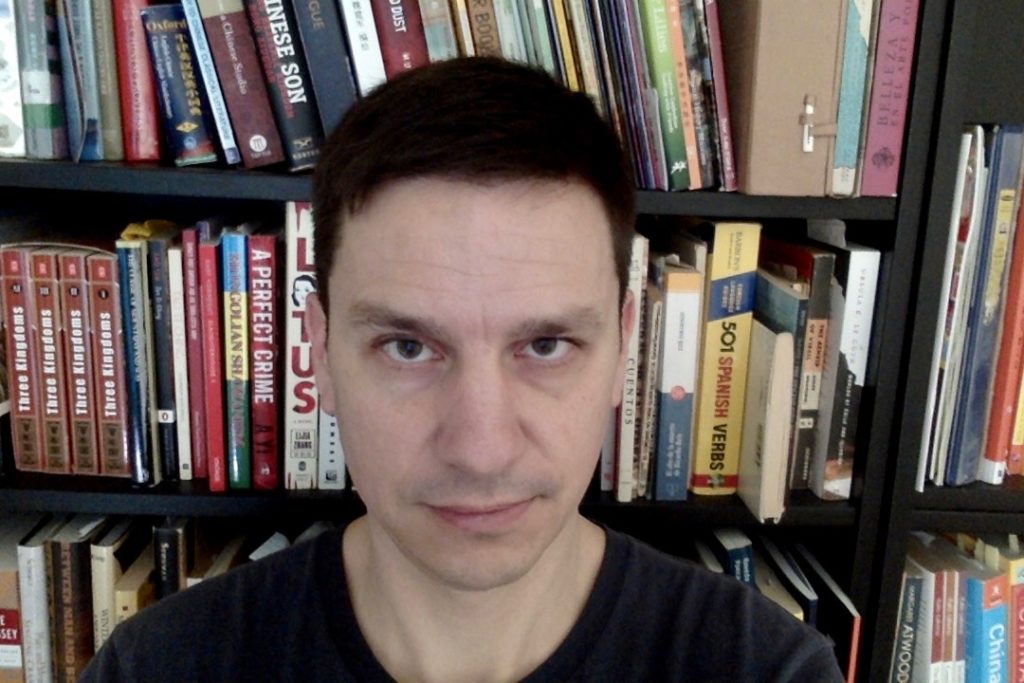
Deva Eveland spends a lot of time pacing around the apartment. His unfinished projects are mostly piled on two desks, though there is also a corner of the kitchen table and then a section of the floor next to the bookshelf. He prefers cats over dogs, coffee over tea, and sasquatches over humans.
Spittoon Monthly publishes one exceptional short story or set of poems on the first Monday of every month.
